Share this
Transforming MJF/SLS Powder: From Waste to 3D Printing Filament
by Ellie Pritchard on Jun 4, 2024 2:23:52 PM
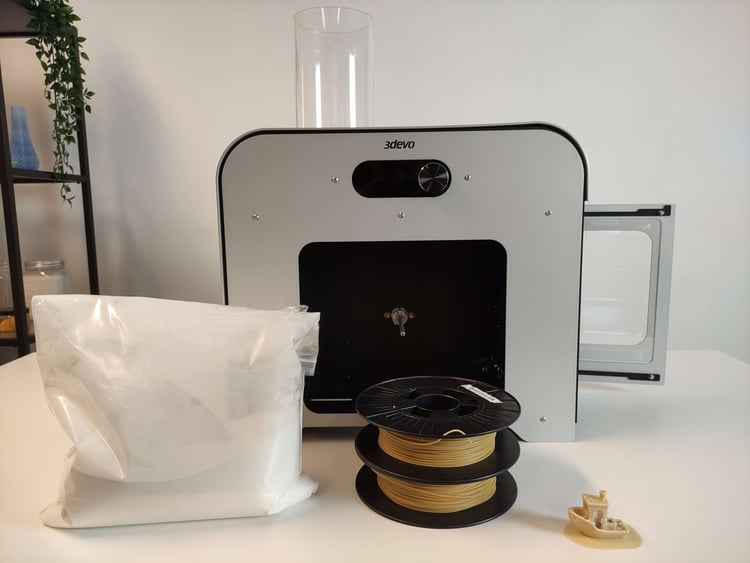
Selective Laser Sintering (SLS) is a powerful 3D printing technique. It uses a laser to bind nylon-based powder to create very small but highly detailed parts. During this process, an MJF (multi-jet fusion) printer spreads a uniform layer of powder and then accurately sinters it. This cycle of powder deposition and sintering is repeated until the part is fully formed. SLS is useful for producing precise, geometrically complex parts, typically in the aerospace and automotive industries.
In this blog, we explore how our 3devo Materials Specialists have turned SLS waste powder into 3D printing filament, providing a recycling solution that a new customer in the US had been seeking for several years.
What are SLS and MJF Printing?
Selective Laser Sintering (SLS) operates by utilizing a high-powered laser to selectively fuse powdered material layer by layer, creating a solid structure. This method is especially well-suited for producing complex geometries that would be difficult to achieve with traditional manufacturing techniques.
The process begins with a thin layer of typically nylon-based powder spread evenly across the build plate. The laser then sinters the powder, solidifying specific areas while leaving the rest of the powder loose. Once a layer is completed, the build plate lowers slightly, and a new layer of powder is applied. This cycle repeats until the entire object is formed.
One of the primary advantages of SLS is its ability to produce parts with complex mechanical properties and high detail resolution. This makes it ideal for applications in industries such as aerospace, automotive, medical devices, and consumer goods. For example, aerospace companies use SLS to create lightweight yet strong components that can withstand extreme conditions, while medical device manufacturers produce custom prosthetics and implants tailored to individual patients.
The need to recycle and reuse powder efficiently is a common concern, especially given the high cost of materials such as nylon powder. For example, after each print, a significant amount of the powder (around 60%) becomes waste and is unusable for further prints, highlighting the necessity for effective recycling solutions.
The Backstory
This project began with a customer from the US who had been struggling to recycle their SLS powder for over seven years. The customer was motivated to recycle the powder for environmental and economic reasons. The nylon powder is expensive to purchase, compounded by the fact that to ensure ongoing high quality & resolution, it was necessary discard a significant amount of powder after each print run. As a result, this was driving up the cost of each prototyped part, limiting the use of the machine and slowing project progression. Had the company been based in Europe, the cost of such waste disposal would have been even higher.
At 3devo, we took on the challenge and successfully demonstrated how to transform this waste powder into filament for 3D printing.
How 3devo Recycles SLS Powder
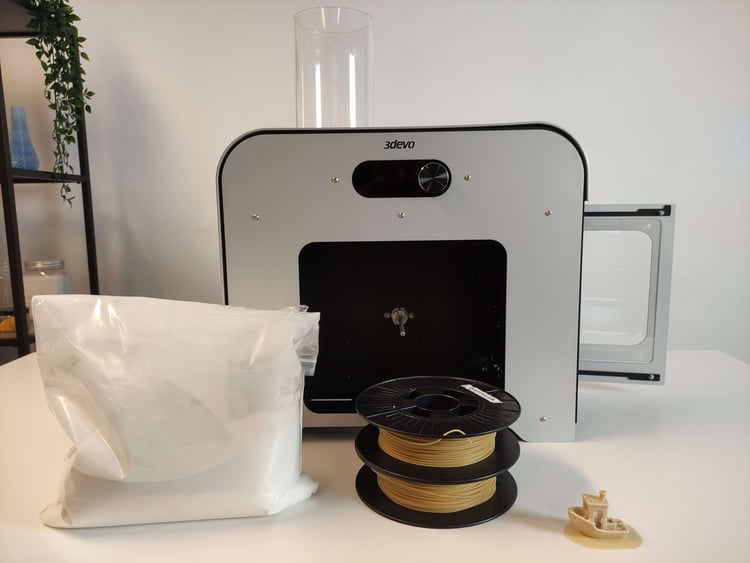
Safety First
Selective Laser Sintering (SLS) relies heavily on nylon powder, known for its mechanical properties and resistance to chemicals. However, the fine nature of the powder requires careful handling and preparation to ensure the safety of those working with it and optimize its performance during the extrusion process. Due to its micron scale size, nylon SLS powder can easily absorb moisture from the air, which can adversely affect the quality of the final printed parts. For this reason, the powder must be thoroughly dried before use to prevent moisture-related issues such as bubbling, which would lead to an inconsistent filament.
Handling fine powders such as this requires strict safety precautions. Due to the potential health hazards associated with inhaling fine particles, it is essential to use personal protective equipment such as protective eyewear, face masks, and gloves. These precautions help to prevent respiratory issues and skin irritation, ensuring a safe working environment.
The Drying Process
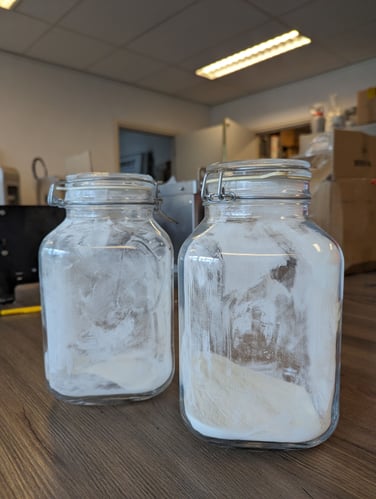
The drying process is a critical step in preparing SLS powder for extrusion. The powder must be spread in a very thin layer on an oven sheet and heated at a low temperature, approximately 85 degrees Celsius, for about 45 minutes. This gentle heating ensures that any absorbed moisture is effectively removed without degrading the material properties of the powder.
After drying, the SLS powder must be cooled down to room temperature before it can be used. This is done by transferring the dried powder to an air-tight container to prevent reabsorption of moisture. Desiccant sachets are added to the container to keep the air dry and maintain the powder's quality. The cooling process typically takes around 30 to 45 minutes. It is important to allow the powder to cool gradually because rapid temperature changes can again lead to inconsistencies in the filament during extrusion.
Recap
To ensure consistent powder quality throughout the preparation process, several best practices should be followed. First, always store the powder in a dry, cool place away from direct sunlight and humidity. Use air-tight containers with desiccants to maintain dryness and prevent outside contaminants (dust, etc). Regularly check and replace the desiccants to ensure they are effective. Additionally, always handle the powder in a controlled environment where a consistent temperature and humidity are maintained and monitored on an ongoing basis. By following these practices, the powder's quality can be preserved, leading to better performance during the printing and extrusion processes.
Extrusion Process
The extrusion process begins with a pre-extrusion setup, which is crucial for ensuring that the filament produced is of high quality and free from contamination. Before adding the SLS powder to the Filament Maker, it is essential to purge the machine with DevoClean Midtemp (our specially developed cleaning material provided with the machine, and available for restock from our website). This step is vital to clean the inside of the machine and screw and remove any residual material from previous extrusions. Any leftover degraded material can contaminate the new filament, leading to inconsistencies and defects.
To begin the pre-extrusion setup, start by heating the Filament Maker to the appropriate temperature indicated for DevoClean Midtemp. Run the DevoClean material through the machine until it comes out clean, indicating that any previous material has been purged. Once the machine is clean, you can then add the SLS powder to the machine’s hopper – the extrudate will change to a beige-like color. It is important to wait until the consistency of the extrudate changes from a foamy texture (caused by residual DevoClean material) to a smooth, consistent flow. At this point, we can start the extrusion process.
When extruding the SLS powder, it is important to use a high RPM for the screw speed to facilitate the transition from cleaning materials to the SLS powder. This high RPM ensures that the powder is evenly distributed and melts uniformly. As the powder is extruded, the cooling process plays a crucial role in maintaining filament consistency. The fans in the Filament Maker should be set to a moderate speed, around 50%, to cool the extrudate gently and evenly. This cooling prevents the filament from becoming too brittle or retaining too much heat, which could lead to diameter inconsistencies.
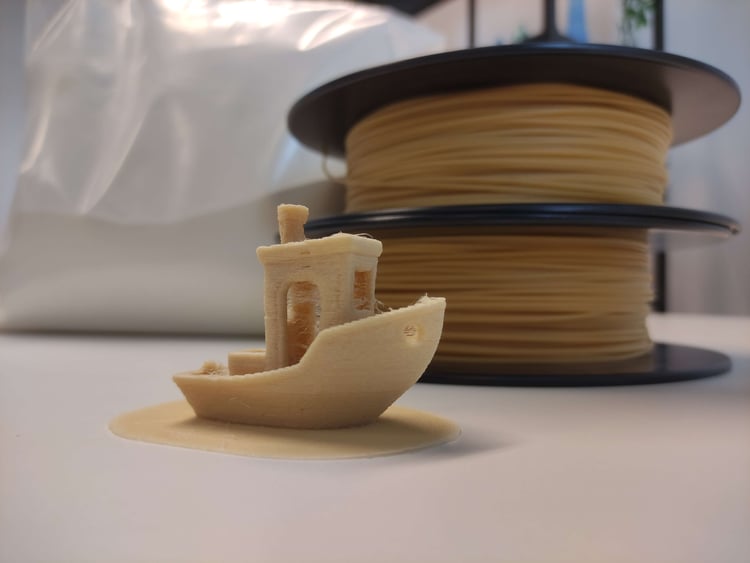
Printing quality is impacted by 3D printer settings, so our focus is on optimizing extrusion settings rather than perfecting printing settings.
Adjusting the extrusion speed is also important for achieving optimal results. A slower extrusion speed allows more time for the fans to cool the filament, which can help in maintaining a consistent diameter. During the initial extrusion phase, the extruded material may have a foam-like consistency due to residual DevoClean. This stage, known as the optimization stage, is where you wait for the extrudate to transition to a smooth, uniform filament. Once the extrudate appears consistent and free of foam, you can proceed with the spooling process. At this point, we turn our attention to the puller wheel. Carefully thread the filament through the puller wheel, ensuring it is properly aligned. Monitor the diameter of the filament using the machine’s integrated display or our desktop app DevoVision, which provides measurements every 20 seconds. The desired diameter range is typically between 1.65mm and 1.85mm to meet industry standards. If the diameter falls outside of this range, adjust the extrusion speed and cooling settings accordingly.
Finally, the spooling process involves cutting away excess filament and guiding the filament through the spooler. Ensure that the filament threads are aligned correctly on the spool to prevent tangling. Maintain consistent tension during the spooling process to ensure smooth and even winding. Regularly check the hopper to ensure it is adequately filled and monitor the filament quality periodically. By following these steps and maintaining attention to detail, the extrusion process can produce high-quality filament that is ready for use in 3D printing. In just a few hours, we can transform waste SLS powder into 300-600 grams of reusable filament. This innovative process not only provides a sustainable solution but also turns waste into a valuable resource, showcasing our commitment to enabling innovations in 3D printing.
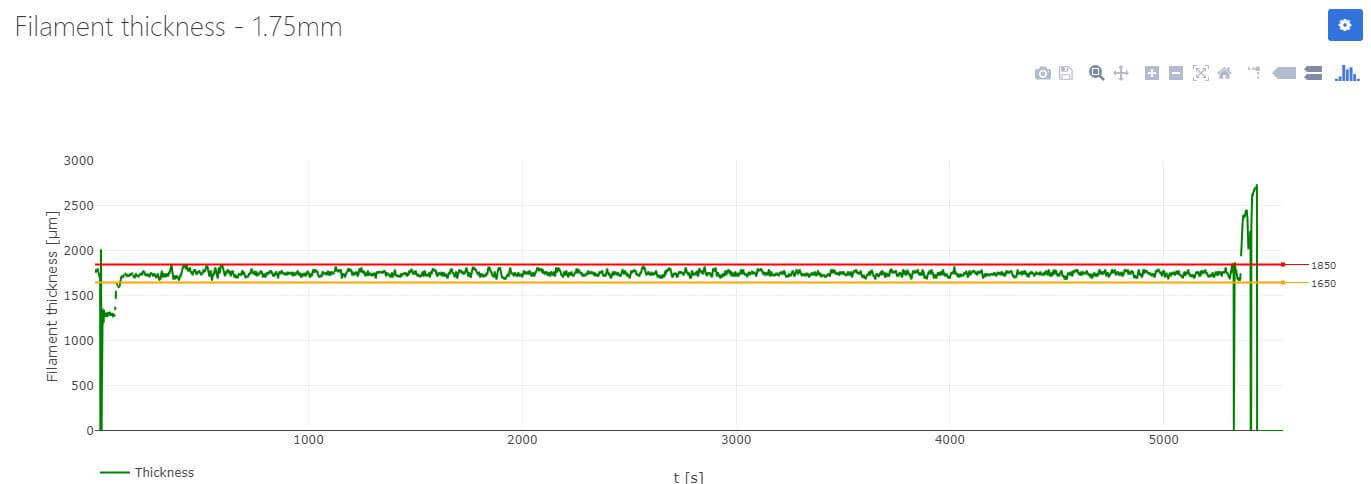
The extrusion process requires careful preparation, precise control of extrusion and cooling parameters, and diligent monitoring to produce high-quality filament from SLS powder. By following best practices and maintaining a clean and controlled environment, the transformation of waste powder into valuable filament can be successfully achieved.
Project Impact
Our ability to recycle waste SLS powder into new filament is a significant step to improving sustainability of 3D printing and manufacturing.
One of the most pressing challenges in 3D printing, particularly with SLS and MJF technologies, is the generation of waste material. Traditional SLS and MJF processes often result in a substantial amount of leftover powder—up to 60%—that cannot be reused in subsequent prints. This not only leads to significant material wastage but also poses disposal challenges, given the fine and potentially hazardous nature of the powder.
By converting what was previously discarded into valuable printing material, 3devo not only reduces the volume of waste but also mitigates the environmental impact associated with powder disposal. The financial implications of waste SLS powder are significant. High-quality PA12 nylon powder, commonly used in SLS and MJF printing, is expensive, with costs potentially reaching $60 per kilogram. For companies that rely heavily on these technologies, the financial burden of wasted powder can be substantial, affecting their bottom line and limiting their ability to scale operations.
By offering a solution to recycle this powder into new filament, 3devo provides a cost-effective alternative that optimizes the use of raw materials. Companies can significantly reduce their material costs by reusing the powder, leading to greater financial efficiency and potentially lower prices for end users.
Enabling Sustainable Practices
The recycling capability of our machines is not just a technical achievement; it is a driver of sustainable innovation within the 3D printing industry. Sustainability is becoming an increasingly critical factor in manufacturing, with companies and consumers alike wanting to see more environmentally friendly practices. 3devo's solution aligns perfectly with these growing demands, offering a practical way to reduce the environmental footprint of 3D printing.
Beyond this, the ability to recycle and reuse materials can inspire further innovation. As companies see the tangible benefits of sustainable practices, they are more likely to invest in and develop new technologies and processes that prioritize environmental responsibility. We hope to see a ripple effect, where the entire industry moves towards more sustainable and efficient methods of production.
Expanding the Possibilities of 3D Printing
The successful transformation of waste SLS powder into new filament also expands the possibilities of 3D printing itself. It opens up new avenues for experimentation and application, as we believe customers will no longer be constrained by the cost and availability of fresh powder. This can lead to more frequent prototyping, greater customization, and the ability to take on more complex projects that would have been prohibitively expensive with traditional materials.
In particular, labs and educational institutions can see great benefits from this innovation. With reduced material costs, schools and universities can integrate 3D printing more readily into their curriculum, providing students with hands-on experience and fostering the next generation of engineers, designers, and innovators.
Looking ahead, 3devo's ability to recycle SLS powder into filament sets a precedent for future developments in 3D printing and material science. As the technology continues to evolve, we are excited to discover even more opportunities for recycling complex materials, reducing waste and enhancing the sustainability of manufacturing processes!
Conclusion
3devo’s innovative approach to transforming waste SLS powder into reusable 3D printing filament showcases our commitment to sustainability and efficiency in additive manufacturing. By tackling material wastage, we provide a cost-effective and eco-friendly solution, benefiting industries like aerospace, automotive, and medical devices, as well as educational institutions.
Our success in recycling SLS powder demonstrates the practical benefits and potential for widespread application. This breakthrough not only reduces costs and environmental impact but also fosters innovation and experimentation within the 3D printing community.
At 3devo, we are dedicated to pushing the boundaries of sustainable 3D printing. We look forward to exploring more opportunities to recycle complex materials and drive the industry towards a greener future. Thank you for joining us on this journey towards a more sustainable and efficient 3D printing landscape.
Video of SLS Powder Printing
Share this
- March 2025 (1)
- January 2025 (1)
- December 2024 (2)
- November 2024 (3)
- October 2024 (4)
- September 2024 (2)
- August 2024 (3)
- July 2024 (6)
- June 2024 (3)
- May 2024 (2)
- April 2024 (1)
- March 2024 (1)
- January 2024 (1)
- November 2023 (2)
- October 2023 (5)
- September 2023 (2)
- August 2023 (1)
- July 2023 (1)
- May 2023 (1)
- December 2022 (3)
- August 2022 (1)
- June 2022 (1)
- May 2022 (2)
- April 2022 (2)
- March 2022 (7)
- February 2022 (2)
- January 2022 (3)
- December 2021 (3)
- November 2021 (3)
- October 2021 (2)
- September 2021 (3)
- August 2021 (3)
- July 2021 (2)
- June 2021 (1)
- March 2021 (1)
- October 2020 (1)
- June 2020 (1)
- May 2020 (1)
- April 2020 (4)
- November 2019 (1)
- July 2019 (2)
- June 2019 (1)
- May 2019 (1)
- March 2019 (1)
- November 2018 (1)
- September 2018 (1)
- January 2018 (1)
- October 2017 (1)
- September 2017 (1)
- July 2017 (1)
- June 2017 (1)
- May 2017 (1)
- January 2017 (1)
- December 2016 (3)
- November 2016 (2)
- October 2016 (1)
- May 2016 (2)
- August 2015 (2)
- July 2015 (1)

